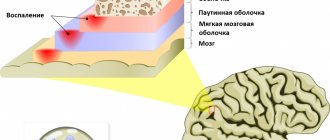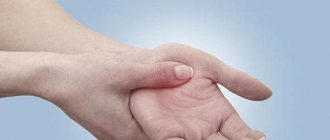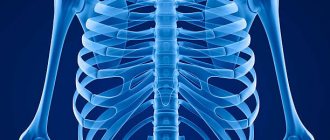The scalp becomes numb most often due to osteochondrosis of the cervical spine, when the nerve fibers are pinched by bony protrusions. The cause may be compression by tense neck muscles due to an uncomfortable posture during sleep or work, or muscle spasm due to neck pain.
The frontal part of the head becomes numb with trigeminal neuralgia, and numbness of the ear and half of the face occurs with neuritis of the facial nerve. Unilateral damage is typical for migraine attacks and strokes, and the vertex loses sensation when the occipital nerve is pinched.
Dangerous symptoms include sudden numbness with general weakness and lack of sensation in half of the head, arm or arm and leg on one side, then you need to call an ambulance.
For a routine examination, you need to contact a neurologist. He conducts a study of the neurological status (skin tests, reflexes), prescribes x-rays of the cervical spine, MRI, and blood tests. To treat radicular syndrome (the most common cause), painkillers (Diclofenac), vitamins (Milgamma), improving blood circulation (Trental), muscle relaxants (Sirdalud), exercise therapy, massage, and physiotherapy are prescribed.
Not a sign of illness, but a temporary glitch
Sometimes the problem is not so bad if it is not directly related to health. In some situations, numbness in the head is considered normal, since overstrained muscles are to blame.
Short-term numbness or tingling is usually observed after waking up if the person took uncomfortable positions during sleep.
Being in one position for a long time (for example, sitting at a computer), the muscles experience severe tension and become “numb.” Compression or pinching of the nerve may also occur.
A feeling of numbness in the head and goosebumps are considered normal even with sudden movements of the neck. In such a situation, the blood vessels experience an unexpected spasm.
Each of these moments is accompanied by disruptions in the blood circulation of the brain, which sometimes leads not only to numbness, but also to dizziness. The condition, which is considered normal, lasts for 10-15 minutes. It is enough to wait until the discomfort passes.
Temporary disruptions can be caused by exposure to certain medications. Numbness of the head is often accompanied by taking statins. It is enough to stop taking them, and the symptoms will go away on their own.
Treatment methods for loss of sensation in the head
The scope of treatment for loss of sensation in the head completely depends on the disease. For example, for the most common disease – osteochondrosis, the following is prescribed:
- painkillers from the group of non-steroidal anti-inflammatory drugs: Diclofenac, Ketonal, Ibuprofen;
- relaxing muscles: Mydocalm, Sirdalud;
- decongestants: Hypothiazide, Lasix;
- stimulating metabolic processes: Rumalon, Actovegin;
- improving nerve functions: Milgamma, Berlition;
- facilitating venous outflow: Troxevasin, Aescusan;
- normalizing microcirculation (Trental, Xanthinol nicotinate);
- activating the transmission of nerve impulses: Neuromidin.
The required group of drugs is selected based on the prevailing symptoms. In addition to medications, it is recommended to wear a Shants collar to relieve the load on the spine. Physiotherapy helps well - in the acute stage, UHF, the introduction of Hydrocortisone with ultrasound, acupuncture, and during the recovery period massage and physical therapy are indicated.
A similar approach is used in the treatment of neuritis and neuralgia. If there is a tumor process, a herniated disc, or spinal instability, surgery is needed. It is also recommended if the full course of drug therapy is ineffective.
If the cause of numbness is cerebral vascular disease, then the following drugs are used:
- cholesterol-lowering drugs (Vasilip, Roxera);
- calcium channel blockers (Corinfar, Nimotop);
- improving cerebral blood flow (Pentilin, Bilobil);
- reducing blood viscosity (Curantil, Aspirin);
- protecting against lack of oxygen (Nootropil, Ceraxon);
- B vitamins (Neurobion, Milgamma).
Neurological and other diseases
There are many reasons why the head goes numb in one part or another, but very often this is a symptom of one of the neurological diseases:
- Often this condition is accompanied by problems of the cervical spine. The most common disease in this area is osteochondrosis , which leads to pinched nerves, which provokes not only discomfort in tactile sensations, but also stiffness in head movements.
- Vascular diseases of the brain and cerebrovascular disease are another diagnosis in which the described symptom is present.
- Such symptoms are also observed with head and spinal injuries . Injuries to the back or cervical region, as well as the head, are accompanied not only by “goosebumps” on the body, but also by severe pain, paralysis and many other symptoms.
- It cannot be avoided without numbness of the scalp and with neuroinfections .
- multiple sclerosis develops , the essence of which is the replacement of nervous tissue with connective tissue. This results in numbness of the skin on the head, poor sensitivity of the limbs, and incoordination.
- Tumors of the head or spine , growing, begin to put pressure on neighboring areas, expanding their space. Nerves and blood vessels come under pressure (and displacement), and metastases penetrate the tissue. The processes are accompanied not only by numbness, but also by very severe pain.
The most serious diseases for which numbness is a mandatory symptom relate to the field of oncology. The tumor can be localized in the cervical region or in any part of the brain.
Numbness, goosebumps and tingling are manifestations of sensitivity of the scalp, and the longer such sensations last, the more compelling the reasons that provoke them should be.
The most harmless are colds associated with hypothermia.
Heart disease, hypertension, excess weight lead to disruption of normal blood circulation, which causes vasospasm, resulting in numbness. This condition can be regarded as pre-stroke.
It is impossible to diagnose or eliminate all these factors independently (without the participation of doctors). Therefore, traditional treatment is excluded a priori here.
Diagnosis of the condition
To make a diagnosis, you need to contact a neurologist, he will conduct an examination and determine the localization of numbness using skin tests, then identify the circumstances of the complaints (for example, previous trauma, infection, hypothermia). Information about concomitant diseases (hypertension, diabetes) will be important. The rate of increase in symptoms allows you to narrow the direction of the diagnostic search. For example:
- instant numbness occurs with stroke and injury;
- during infection, symptoms increase from several hours to 2-3 days;
- weeks and months covering an increasingly larger area are typical for the tumor process, multiple sclerosis.
To clarify the affected area and the cause of numbness, the following is prescribed:
- X-ray of the cervical spine;
- Ultrasound of head and neck vessels;
- neurophysiological testing (electroneuromyography) – determining the speed of propagation of a nerve signal;
- MRI of the brain;
- blood tests: general, biochemistry (renal tests, glucose, glycated hemoglobin, magnesium, calcium, potassium, sodium), level of vitamin B12, folic acid;
- test for thyroid-stimulating hormone of the pituitary gland;
- immunological tests (for antibodies if infection is suspected, plasma protein electrophoresis).
The patient may need to consult an infectious disease specialist, endocrinologist, oncologist, or surgeon.
Features of the clinical picture and localization of sensations
When numbness of the head does not belong to the category of normal, then we are talking about the clinic, the etiology of which can only be determined by a doctor.
Having assessed the nature of the symptoms, the location of the sensations, taking into account the presence of specific diseases, as well as carrying out the appropriate diagnostics, the specialist will render his verdict.
Numbness of the head can be complete, but sometimes only a specific part of it is affected, which indicates dysfunction of certain organs. The nervous system most often affected is:
- If the left or right side of the head goes numb, then the culprit may be vessels in which blood circulation is impaired, or pinched nerves. But sometimes the cause is brain pathologies and cerebral tumors.
- If the back of the head , then usually the cause is cervical osteochondrosis or other disorders of the cervical region.
- Numbness and tingling in the front of the head is caused by inflammation of the trigeminal nerve. A sign of this is pain radiating to the jaw, ear and eye.
- The frontal part is affected by increased intracranial pressure.
A problem localized to only one side of the head indicates a pathology of the cerebral structure. In this case, the focus is concentrated in the opposite area of the skull.
Symptoms
The main characteristic symptom of trigeminal neuralgia is paroxysmal pain. It comes suddenly and in its intensity and speed of spread resembles an electric shock. Typically, intense pain forces the patient to freeze in place, waiting for relief. The attack can last from a few seconds to 2-3 minutes, after which there is a period of calm. The next wave of pain may come within hours, days, weeks or months.
Over time, the duration of each attack of neuralgia increases, and periods of calm are reduced until a continuous aching pain develops.
The provoking factor is irritation of trigger points:
- lips;
- wings of the nose;
- eyebrow area;
- middle part of the chin;
- cheeks;
- area of the external auditory canal;
- oral cavity;
- temporomandibular joint.
A person often provokes an attack when performing hygiene procedures (combing hair, caring for the oral cavity), chewing, laughing, talking, yawning, etc.
Depending on the location of the lesion, the pain takes over:
- the upper half of the head, temple, orbit or nose if the ophthalmic branch of the nerve is affected;
- cheeks, lips, upper jaw – if the maxillary branch is affected;
- chin, lower jaw, as well as the area in front of the ear - with neuralgia of the mandibular branch.
If the lesion affects all three branches or the nerve itself before it is divided, the pain spreads to the entire corresponding half of the face.
Painful sensations are accompanied by other sensory disturbances: numbness, tingling or crawling sensations. Hyperacusis (increased hearing sensitivity) may be observed on the affected side.
Since the trigeminal nerve contains not only sensory, but also motor pathways for the transmission of impulses, with neuralgia the corresponding symptoms are observed:
- twitching of facial muscles;
- spasms of the muscles of the eyelids, masticatory muscles;
The third group of manifestations of neuralgia are trophic disorders. They are associated with a sharp deterioration in blood circulation and lymph outflow. The skin becomes dry, begins to peel, and wrinkles appear. Local graying and even hair loss in the affected area is observed. Not only the scalp suffers, but also the eyebrows and eyelashes. Impaired blood supply to the gums leads to the development of periodontal disease. At the time of the attack, the patient notes lacrimation and drooling, swelling of the facial tissues.
Constant spasms of muscle fibers on the diseased side lead to facial asymmetry: narrowing of the palpebral fissure, drooping of the upper eyelid and eyebrow, upward movement of the corner of the mouth on the healthy side or drooping on the diseased side.
The patient himself gradually becomes nervous and irritable, and often limits himself to food, since chewing can cause another attack.
Diagnostic measures
A multifaceted examination of the patient’s condition will help the doctor determine the location of the source of the problem and its cause. In addition to visual diagnosis and analysis, a differential study is added, which allows one to completely determine the cause and extent of the lesion.
Set of research procedures:
- start with a general blood test , which allows us to identify a lack of vitamin B12 in the body and the presence of iron deficiency anemia;
- instrumental studies such as radiography and spiral computed tomography will make it possible to assess the condition of the brain, skull, spine and identify pathologies if they are present;
- Electroneuromyography will help find the damaged nerve ;
- Doppler ultrasound makes it possible to assess the condition of blood vessels and help diagnose diseases of the cardiovascular system;
If after these studies and tests the picture remains not completely clear, the doctor will prescribe additional procedures based on the patient’s condition.
First aid
When there is short-term numbness of the head, which is normal, you can relieve tension with a light massage.
If there is discomfort caused by pathology, this will not work - you must first eliminate the cause (and only a doctor can identify it). You should not look for ways to “help” yourself, so as not to harm yourself even more with self-medication.
The main step that the patient must take is to immediately go to a medical facility. If you cannot do this yourself, you must call an ambulance.
When do you urgently need to see a doctor?
Not everyone perceives periodically occurring long-term numbness and tingling in the head as a reason to see a doctor. But when the following accompanying symptoms occur, it’s time to sound the alarm:
- Tingling and numbness are often accompanied by dizziness and lightheadedness . Here, constant drowsiness, general weakness and unsteadiness of gait are possible.
- Nausea appears, often ending in vomiting . It is difficult for the patient to control the bladder - it is emptied involuntarily.
- , musculoskeletal dysfunction may occur . Problems arise either in individual parts of the body, or complete paralysis occurs.
- Difficulty with movement also affects speech , the tongue becomes numb, and it is impossible to understand what the person is saying.
Even one of the factors described is already a serious reason to visit a neurologist or surgeon if it is related to injury.
Treatment approach
Complex treatment is prescribed only after a complete examination of the patient. The doctor prescribes medications individually for each patient, taking into account the reasons that led to numbness of the head.
The first step in therapy will be blocking pain, reducing temperature (if present) and administering drugs that restore circulatory function.
If numbness is a symptom of one of the diseases, then the main goal will be to treat this disease. In some cases, you will have to settle for long-term therapy and no less long-term rehabilitation.
A positive treatment outcome in this situation will depend not only on the doctors, but also on the patient himself, who takes full responsibility for his condition.
The symptoms described above should not be ignored. The sooner the patient goes to a medical facility, the easier and faster the treatment will be. Every day of delay reduces the chances of recovery and provokes serious consequences.
Treatment of trigeminal neuralgia
Treatment is aimed at:
- to eliminate the cause of damage;
- to alleviate the patient's condition;
- to stimulate the restoration of nerve structures;
- to reduce the excitability of trigger zones.
Properly selected treatment can reduce the frequency, intensity and duration of pain waves, and ideally achieve stable remission.
Drug treatment
Trigeminal neuralgia requires complex treatment using drugs from several groups:
- anticonvulsants (carbamazepine and analogues): reduce the excitability of nerve fibers;
- muscle relaxants (baclofen, mydocalm): reduce muscle spasms, improve blood circulation, reduce pain;
- B vitamins (neuromultivit, milgamma): stimulate the restoration of nerve fibers, have an antidepressant effect;
- antihistamines (diphenhydramine): enhance the effect of anticonvulsants;
- sedatives and antidepressants (glycine, aminazine): stabilize the patient’s emotional state.
For severe pain, narcotic analgesics may be prescribed. Previously, drug blockades (injecting the problem area with anesthetics) were actively used, but today this method of treatment is almost never used. It contributes to additional damage to nerve fibers.
Treatment of the root cause of the disease is mandatory: elimination of dental problems, taking medications to improve cerebral circulation, etc.
Physiotherapy and other non-drug methods
Non-drug methods complement drug therapy well and help stabilize patients’ condition. Depending on the condition and concomitant diseases, the following may be prescribed:
- ultraviolet irradiation: inhibits the passage of impulses along nerve fibers, providing an analgesic effect;
- laser therapy: reduces pain;
- UHF therapy: improves microcirculation and prevents muscle atrophy;
- electrophoresis with analgesics or antispasmodics to relieve pain and relax muscles;
- diadynamic currents: reduce the conductivity of nerve fibers, significantly increase the intervals between attacks;
- massage of the face, head, cervical-collar area: improves blood circulation and lymph outflow, improving tissue nutrition; must be carried out with caution so as not to touch trigger zones and provoke an attack; the course is carried out only during the period of remission;
- acupuncture: helps relieve pain.
Surgery
The help of surgeons is indispensable when it is necessary to eliminate nerve compression. If indicated, the following is carried out:
- removal of tumors;
- displacement or removal of dilated vessels pressing on the nerve (microvascular decompression);
- expansion of the bone canals in which the branches of the nerve pass.
A number of operations are aimed at reducing nerve fiber conductivity:
- exposure to a gamma knife or cyber knife;
- balloon compression of the trigeminal node: compression of the node using an air-filled balloon installed in close proximity to it, followed by death of the nerve fibers; surgery often leads to partial loss of sensation and decreased muscle movement;
- resection of the trigeminal node: rarely performed due to the complexity and large number of complications.
Make an appointment











